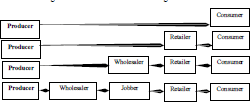Marketing channels are described by the levels involved. Each layer of middlemen that performs some work in bringing the product and its ownership closer to the final buyer is a channel level. Because the producer and the final consumer will perform some work, they are part of every channel.
We use the number of intermediary levels to indicate the length of a channel. Institutions through the channel are connected with different types of flows. These include the physical flow of products, the flow of ownership, the payment flow, the information flow, and the promotion flow.
We shall now look at two marketing channels – channels for consumer goods and channels for industrial goods.
Read Also: Composition and Functioning of the Marketing Environment
Marketing Channels

Producer to the Consumers
When there are no intermediaries between the producer and the consumer, the channel becomes direct. This type of channel is most commonly used with organizational products, especially where the product is new. It is centered on creating awareness and gaining access to target consumers.
Producer to Retailer to the Consumer
The channel from producer to retailer to consumer is basic when the retail establishments involved are relatively large.
Producer to Wholesaler to Retailer to the Consumer
It employs a wholesaler to take care of the shipping and transportation needs. Wholesalers offer the accumulating and allocating functions that allow small producers to interact with large retailers, and vice versa.
Producer to Wholesaler to Jobber to Retailer to the Consumer
The producer uses agents (Jobbers) to assist the wholesalers in marketing goods. The use of Jobbers could be based on their specialized experiences.
Manufacturer to Industrial Customer (Buyer)
From the diagram above, manufacturers use direct marketing to distribute their products to industrial users. It is associated with complex products that require a good deal of pre-sale and post-sale support.
Know that post-sale support is often best handled through a direct channel because the manufacturer might be the only entity with sufficient expertise to help the customer.
After all, these large accounts generate enough business to support the sales effort involved, and large customers have a habit of going through their economic weight to demand personalized service.
Manufacturer to Industrial Distributor to Industrial Customer
It is the most used channel for industrial products. Distributors take title to the goods and specialize in different lines of goods.
Some of the disadvantages associated with this channel are that:
Distributors will want access to large accounts that the manufacturer may keep it.
Sometimes distributors do not always respond to manufacturers’ advice regarding promotions, pricing, and operational policies.
The fourth channel of distribution is adopted by manufacturers who wish to control the marketing activities of their products.
However, titles to the goods are given to industrial distributors, who sell to industrial customers when needed and in the needed quantity.
Read Also: Definition of Products and the Different Product Levels
